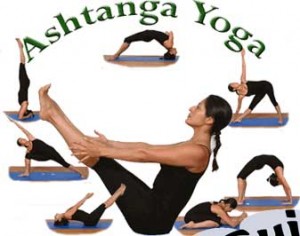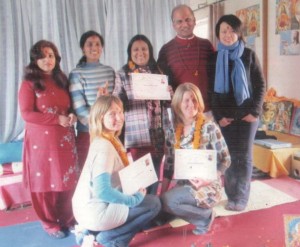Yoga teachers training course is being organised by Chetana Yoga from 17th September, 2013 to 25th October, 2013 in Thamel, Kathmandu center. The course is provided by the famous and experienced Yoga Master Dr. Chetnath Adhikari (Yogiananada).
Training Schedule 2013-2014
Class Start Date |
Class End Date |
| 17 September 2013 | 25 October 2013 |
| 01 November 2013 | 30 November 2013 |
| 15 February 2014 | 16 March 2014 |
| 16 April 2014 | 16 May 2014 |
| 21 August 2014 | 20 September 2014 |
| 07 November 2014 | 06 December 2014 |
Overview of Yoga Teacher’s Training Course
Daily Schedule: Morning 8 am – 4 pm (Sunday to Friday)
10:00 am: breakfast break for 90 minutes/1:30 pm: lunch break for 90 minutes
Meal: Breakfast and Lunch in Yoga studio
Accommodation: Guest room in Private house/Hotel
Location: Thamel, Kathmandu
Yoga Tour: 3-4 days at natural place out from Kathmandu (Trishuli, Country side)
Yoga Teacher’s Training (Detail)
| Yoga Method (Philosophy part) | Pranayama |
| Introduction to yoga / Yoga History / Effect of yoga on body and mind / Kind of yoga / Information about eastern Hindu culture and philosophy / General notes for yoga practioner / Method of healthy living | Yogic breathing / Uggai / Chandravedi / Suryavedi / Nadisodhana / Bastrika / Setali and sitakari / Bhramari / Anuloma beloma |
| Meditation Types | Mudra |
| Third eye / Bipasena / Felling the body awareness / Dynamic Meditation /Crying Meditation / Laughing Meditation / Walking Meditation / Sound Meditation / Chakra Mediation | Sambhabi / Bhuchari / Gyana and Chin / Nasikagra Dristi / Aswayoni mudra / Akashi Mudra / Yoni Mudra / Yoga Mudra / Khechari Mudra |
| Yogic Six Cleansing (satkarma) | General knowledge of Naturopathy |
| Neti / Dhoti / Basti / Nauli /Kapalbhati / Tratak | Knowledge about five elementsTreatment method: (Steam bath, Hotfoot bath, hot cold compression, Wet sheet pack. Massage) |
| Fasting | Yoga to therapeutic purpose |
| Three days fruits fasting practice / Benefits of fasting / Method of fasting | Back pain group / Stomach pain or problem / Depression / Anxiety / Chronic disease |
|
General knowledge of Anatomy and physiology |
|
|
Basic 72 ASANAS |
|
|
Standing Asanas |
|
Balancing: Miscellaneous
Non balancing: miscellaneous
Backward bending
|
Forward Bending
Side Ways Bending
Twisting
|
|
Sitting Asanas |
|
Balancing miscellaneous
Non balancing: miscellaneous
Backward Bending
|
Forward Bending
Sideways twisting
Sideways bending
|
|
Laying category |
|
Balancing Miscellaneous
Non-Balancing Miscellaneous
Sideways twisting
|
Forward Bending
Backward Bending
Sideways bending
|
Types of yoga
- Hatha yoga
- Raja yoga
- Gyana yoga
- Bhakti yoga
- Karma yoga
- Mantra yoga
Yoga and Food
- Satvik Bhogan
- Ragasi Bhogan
- Tamasi Bhogan
Ashram/ Monastary Visit and Meditation
- Osho Tapoban
- Shivapuri Baba
- White Monastery
- Some Hindu temples
Astang yoga
- Yama
- Niyama
- Asana
- Pranayama
- Pranayama
- Dharana
- Dhyana
- Samadhi
Biographies of Yogis (Recommended for study)
- Yogananda
- Raman Maharsi
- Bibekanda
- Khaptad Baba
- Shibapuri Baba
- RamKrishna Paramhansa
Bhajan/ Kirtan/ Mantra/ Chanting
- Aum chanting
- Aum Nam Shibaya
- Guru Bhakti Bhagan
- Narayana Narayana chanting
Astanga Yoga (eight-limb or step yoga)
(Based on yoga sutras by Patanjali)
Introduction to Astang yoga
 In Sanskrit “Astha+anga” is ASHTANGA. “ASHTA means eight and ANGA is limbs, so it means eight limb paths, Ashtanga yoga is based on yoga philosophy of PATANGALI. The Asanas, Pranayama or the Dhahran, which we have studied earlier, or the yam and Niyam are based on the yoga sutras of Patanjali. Hence, we will acquaint ourselves with the fundamentals as stated by Patanjali first.
In Sanskrit “Astha+anga” is ASHTANGA. “ASHTA means eight and ANGA is limbs, so it means eight limb paths, Ashtanga yoga is based on yoga philosophy of PATANGALI. The Asanas, Pranayama or the Dhahran, which we have studied earlier, or the yam and Niyam are based on the yoga sutras of Patanjali. Hence, we will acquaint ourselves with the fundamentals as stated by Patanjali first.
History of Astanga yoga
Yoga has its roots about 5000 years B.C. as described in Vedic Philosophy and ‘Tantras’. Patanjali, great sage composed this path into a Darshan (philosophy) in his book Patanjali yoga sutra. In which he has formulated yoga as a eight limbs or eight fold path.
Eight limbs of Astang yoga
Yama (principles of, moral code, or social disciplines)
- Ahimsa – A principle of Non-violence
- Satya – A principle of Truthfulness
- Asteya – A principle of none stealing
- Brahmacharya – A principle of continence/ celibacy
- Aparigaha – A principle of Non-hoarding or non-possessiveness
Niyama (Personal Disciplines)
- Shoucha – Purity
- Santosh – contentment
- Tapa – Endurance
- Swadhyaya- Self-study
- Eshwar Pyramidal – Dedication
Asana (Yoga postures)
- A stable and comfortable posture, which helps, attains mental equilibrium.
Pranayama: (Yoga Breathing)
- Extension and control of breathing/ breath
Prathayara (withdrawal of senses)
- A mental preparation to increase the power of mind.
Dharana (concentration on object)
- Concentration of mind on one object and its field.
Dhyan (Meditation)
- With drawing mind from all external objects and focusing it on one point and meditating on it or rest the mind is called meditation.
Samadhi (salvation)
- State of super bliss, joy and meaning individual consciousness into universal consciousness. Union between Jivatama (human being or soul) and Paratmatma (super soul). Union of Shiva and Shakti is Sahasrar Chakra (the top of the head) realizing the Brahma (pure consciousness) or Realization of God is the ultimate achievement of human birth.





Hi there. How much is the yoga teacher course?
Thank you
Casper